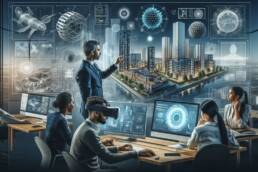The realm of architectural design is undergoing a revolutionary transformation, thanks to the advent of 3D architectural visualization. This cutting-edge approach not only enhances the presentation of architectural projects but also streamlines the entire design and construction process. By providing clients with immersive, photorealistic views of their proposed projects, 3D visualization tools like virtual walk-throughs, VR, and BIM are setting new standards in client engagement, design optimization, and marketing strategies. CG Viz Studio, with its expertise in creating detailed 3D images and animations, is at the forefront of this game-changing movement, offering a glimpse into the future of design where technology and creativity converge to bring visions to life.
Key Takeaways
- 3D architectural visualization is revolutionizing the way architects present and clients perceive future projects, providing a more tangible and immersive experience.
- Virtual reality (VR) and Building Information Modeling (BIM) technologies are enhancing interactive design, allowing for participatory design and better stakeholder engagement.
- Photorealistic renderings and 3D models are optimizing communication between all parties involved in the design and construction process, leading to more efficient project planning.
- High-quality visuals and animations are elevating marketing and sales strategies, enabling pre-sales and better showcasing of properties and product features.
- The future of architectural design technology promises continuous innovation, with 3D visualization tools playing a crucial role in sustainable design and competitive differentiation.
Revolutionizing Architectural Presentation
The Emergence of 3D Architectural Visualization
As we delve into the transformative world of architectural design, we’ve witnessed the emergence of 3D architectural visualization as a pivotal tool. Gone are the days of flat, hard-to-interpret blueprints; now, clients can explore and understand complex designs with ease. Enhanced visualization techniques have allowed us to transform two-dimensional plans into immersive 3D representations, providing a tangible understanding of the final product.
The integration of virtual walk-throughs and interactive models has revolutionized client engagement, allowing for a participatory design process that was previously unimaginable.
Our ability to develop 3D models and provide virtual experiences has not only improved communication but also empowered clients to customize properties before a single brick is laid. Here’s a glimpse at how our services have evolved:
- 3D Architecture Visualization
- Architectural 3D Design and Animation
- 3D Interior Visualization
- 3D Exterior Visualization
Each step forward in this field brings us closer to a future where architectural design is as vivid before construction as it is upon completion.
Enhancing Client Engagement with Virtual Walk-throughs
We’ve embraced the power of virtual walk-throughs to transform the client experience. By developing 3D architectural models, we enable clients to visualize and customize properties before they are built. This immersive approach not only enhances client engagement but also allows for a deeper understanding of the design’s scale, proportion, and ambiance.
Interactive Presentations have become a cornerstone of our client interactions. Stakeholders can navigate through virtual spaces, gaining valuable insights and fostering a sense of ownership. The integration of VR technologies and Building Information Modeling (BIM) further enriches this interactive experience, making it possible to test design alternatives in real-time.
The ability to contextualize designs within existing spaces has revolutionized client presentations and public engagement.
Here are some of the key benefits we’ve observed:
- Improved client comprehension of spatial qualities
- Enhanced public perception through transparent presentations
- Streamlined management of design changes
By leveraging these tools, we ensure that our clients are not just spectators but active participants in the design process. The result is a more informed decision-making process and a project that truly reflects the client’s vision.
The Role of VR and BIM in Interactive Design
We are witnessing a transformative era in architectural visualization, where virtual reality (VR) and Building Information Modeling (BIM) are not just tools but foundational elements in interactive design. We can expect VR to become an integral part of the architectural design process, continually enhancing the way we visualize and interact with future spaces.
Through the integration of VR and BIM, we enable clients to spectate, customize, and even purchase real estate properties in a virtual environment. This immersive approach allows for a deeper understanding of the project and facilitates informed decision-making.
By leveraging game engines alongside BIM, we create participatory design models that significantly enhance user involvement. These interactive models are crucial for testing design alternatives and ensuring that the final product resonates with the intended audience.
Our commitment to innovation is reflected in the way we harness these technologies to improve the design process, client presentations, and public engagement. Below is a list of the strategic advantages VR and BIM offer:
- Immersive client walk-throughs for a lifelike experience of architectural spaces
- Enhanced communication through photorealistic renderings
- Streamlined project planning and stakeholder collaboration
- Flexibility in managing design changes
As we continue to explore the impact of VR on architectural visualization, we remain dedicated to providing our clients with the most cutting-edge and interactive design experiences.
Optimizing Design and Construction Processes
Improving Communication with Photorealistic Renderings
We understand the importance of clear communication in the design and construction industry. Photorealistic renderings bridge the gap between conceptual designs and the client’s vision, ensuring that everyone is on the same page. By providing a tangible representation of the proposed outcome, we preemptively address questions and concerns, streamlining the approval process.
Enhanced public perception is one of the key benefits of utilizing 3D renderings. These visuals can be shared during community meetings or on project websites, fostering transparency and encouraging local support. Moreover, they are instrumental in managing change orders effectively, as stakeholders can visualize design changes within a virtual environment, allowing for more informed decisions.
The true value of 3D architectural rendering lies not just in its aesthetic appeal, but in its ability to influence every stage of the architectural journey, from initial design conception to project completion.
Here’s how our clients have benefited from our services:
- Streamlined project approval
- Positive feedback from community stakeholders
- Efficient change order management
- Increased client satisfaction
Our commitment to excellence in 3D visualization ensures that your projects are not only successful but also resonate with your audience. Let us help you transform your vision into a reality that everyone can understand and appreciate.
Streamlining Project Planning with 3D Models
We’ve seen firsthand how 3D models serve as a cornerstone in streamlining project planning. By creating a virtual representation of the project, we can explore and evaluate design options early on, which leads to informed decision-making and minimizes costly changes later. This proactive approach significantly reduces the risk of project delays and cost overruns.
Facilitating Stakeholder Collaboration is another key benefit of utilizing 3D models. Stakeholders can visualize the project in its entirety, fostering a collaborative environment where feedback is given and changes are made in real-time. This not only improves communication but also ensures that everyone is aligned with the project’s vision and objectives.
By integrating 3D models into our workflow, we’ve transformed the traditional planning process into a dynamic and interactive experience.
Here’s how 3D models have improved our project planning process:
- Enhanced visualization of complex geometries
- Immediate detection of design conflicts
- Simulated real-world conditions for better planning
- Streamlined change order management
With these advancements, we’re not just planning projects; we’re building the future with precision and clarity.
Facilitating Stakeholder Collaboration
We understand the importance of bringing together all parties involved in a project. By integrating 3D architectural visualization into collaborative platforms, we create a common ground for architects, engineers, contractors, and clients. This fosters a transparent and efficient workflow, where each stakeholder can contribute their expertise effectively.
- Iterative Design: 3D models allow for continuous refinement, ensuring that all parties are aligned with the evolving design.
- Enhanced Public Perception: Renderings can be used to foster community support and transparency.
- Streamlined Change Management: Visualizing changes in the design helps stakeholders to quickly understand and approve modifications.
By using 3D models, we can develop immersive experiences that allow stakeholders to visualize projects in a comprehensive manner. This not only improves communication but also enhances the decision-making process, leading to a more cohesive and successful project outcome.
Elevating Marketing and Sales Strategies
Showcasing Properties with High-Quality Visuals
In our pursuit to revolutionize the real estate market, we’ve embraced the power of high-quality 3D renderings to showcase properties in the most compelling light. These visuals not only captivate potential buyers but also convey the architectural vision with stunning clarity. By presenting a lifelike representation of the property, we enable clients to visualize their future homes or investment spaces with ease.
Enhanced public perception and pre-leasing advantages are just the tip of the iceberg when it comes to the benefits of 3D visualization in marketing properties. Our clients have reported significant increases in engagement and interest, leading to a competitive edge in the market. Here’s how 3D renderings have transformed their marketing strategies:
- Securing investment and funding by showcasing potential
- Pre-leasing and sales advantage for developments
- Generating positive public perception for projects
- Streamlining change order management
We’ve seen firsthand how these high-quality visuals can turn a simple blueprint into a vibrant, immersive experience that excites and inspires. This is not just about selling a space; it’s about selling a vision, a lifestyle, and a future that clients can see themselves in.
As we continue to innovate, the strategic use of 3D renderings remains a cornerstone of our marketing and sales approach, providing a clear visual reference that bridges the gap between imagination and reality.
Leveraging 3D Renderings for Pre-Sales
In our quest to revolutionize pre-sales strategies, we’ve embraced the power of 3D renderings to captivate potential buyers and investors before the first stone is even set. These visuals serve as a bridge, transforming abstract ideas into concrete visions of the future. By offering an immersive preview of projects, we not only spark interest but also instill confidence in the project’s potential.
- Securing Investment and Funding: 3D renderings are a powerful marketing tool for attracting investors and securing funding.
- Pre-Leasing and Sales Advantage: Market properties before construction begins, giving you a distinct competitive advantage.
- Facilitating Informed Decision-Making: Early exploration of design options leads to informed choices, minimizing costly changes later.
By integrating 3D visualization into our marketing campaigns, we provide interactive experiences that adapt to market demands and client feedback. This proactive approach not only enhances our presentations but also allows for early detection of design errors, ensuring a dynamic and error-free project development.
Using Animation to Demonstrate Product Features
We understand the power of animation in conveying the intricacies of a product’s features. Animations bring a product to life, offering a dynamic and engaging way to showcase how it functions in real-world scenarios. By animating the product’s features, we can highlight its unique selling points and demonstrate its value proposition effectively.
High-end 3D visualization services are not just about creating stunning visuals; they’re about engaging customers, educating them about the product, and ultimately driving sales. Here’s how we leverage animation in our marketing strategies:
- Demonstrating Functionality: Animations can show how a product works, moving beyond static images to illustrate its use.
- Highlighting Features: Through animation, we can zoom in on specific features, showing them in action and underlining their benefits.
- Emotional Connection: Animated stories can evoke emotions, making the product more relatable and desirable.
- Complex Concepts Simplified: Animation can break down complex ideas into understandable visuals, making it easier for clients to grasp.
By integrating animation into our marketing toolkit, we ensure that our clients’ products are not just seen but experienced. This immersive approach is what sets us apart in the marketplace.
The Strategic Advantage of 3D Rendering Services
Informed Decision-Making through Visualization
We understand the transformative power of 3D architectural visualization in facilitating informed decision-making. By presenting designs in a virtual environment, clients can explore and evaluate various aspects of a project before any physical work begins. Material selections, lighting schemes, and spatial configurations become tangible, allowing for a comprehensive understanding of the design’s scale, proportion, and ambiance.
- Bridging the Gap Between Vision and Reality
- Enhanced Public Perception
- Streamlined Change Order Management
The ability to visualize design changes within the virtual environment allows for a more efficient and collaborative process, minimizing costly changes down the line.
The use of photorealistic renderings not only improves communication between architects and clients but also enhances the public’s perception of a project. This level of interactivity results in more informed decision-making, as all stakeholders can better understand the proposed structure. Moreover, managing design changes becomes more streamlined, reducing the frequency and impact of change orders.
Managing Design Changes with Flexibility
We understand that architectural design is an iterative process, often requiring numerous revisions before reaching the final blueprint. With the flexibility of 3D visualization, we can swiftly adapt to design changes, providing our clients with a dynamic platform for experimentation and refinement. The ability to visualize design changes within the virtual environment allows for a more streamlined change order process. Clients can readily assess the impact of proposed modifications before final approval, minimizing delays and cost overruns.
The precision and flexibility offered by CAD software have revolutionized the way we approach architectural design. We can now create detailed designs with exceptional precision, and the digital platform has made it easier to incorporate intricate details and complex geometries into designs. This opens up new possibilities for us to explore innovative and daring concepts that were previously difficult to achieve manually.
By offering stakeholders a more tangible understanding of the final product, we foster a sense of transparency and encourage local buy-in. Enhanced public perception is just one of the many benefits we gain from utilizing 3D renderings in our presentations and communications.
Here are some key benefits of 3D visualization in managing design changes:
- Streamlined Change Order Management
- Iterative Design
- Precision and Flexibility
- Enhanced Public Perception
Gaining Competitive Edge in the Real Estate Market
In our quest to stand out in the fiercely competitive real estate market, we’ve embraced 3D architectural visualization as a cornerstone of our strategy. By showcasing properties with high-quality visuals, we not only captivate potential buyers but also provide a clearer understanding of our projects. This visual clarity is crucial for communicating ideas effectively, a highlight from the insights on how 3D Architectural Visualisation helps architects win more projects.
The use of 3D renderings in marketing materials allows us to pre-sell units and secure investments even before breaking ground. This proactive approach to sales and marketing gives us a significant advantage over competitors who rely solely on traditional methods.
Here’s how we leverage 3D visualization to gain a competitive edge:
- Securing investment and funding with compelling visuals that generate excitement
- Offering a pre-leasing and sales advantage by marketing properties pre-construction
- Enhancing brand identity through consistent and impactful visual storytelling
Our commitment to innovation and quality in 3D visualization not only sets us apart but also drives our success in the real estate market.
The Future of Architectural Design Technology
Continuous Innovation in 3D Visualization Tools
As we navigate the evolving landscape of architectural design, we recognize the pivotal role of continuous innovation in 3D visualization tools. These advancements are not just enhancing our capabilities but are reshaping the very fabric of how we conceive and present architectural concepts. The flexibility of CAD software, for instance, has empowered us to experiment with rapid design iterations, exploring a multitude of possibilities with ease.
The integration of technologies such as VR and BIM with 3D modeling tools has revolutionized the way we engage with both clients and the design itself. This synergy allows for an immersive experience that is both interactive and highly detailed, providing a comprehensive understanding of the envisioned space.
To illustrate the breadth of services that have been transformed by these innovations, consider the following list:
- 3D Architectural Visualization
- Architectural 3D Design and Animation
- 3D Interior and Exterior Visualization
- Photorealistic Renderings
- Virtual Walk-throughs and Interactive Models
Each of these services benefits from the ongoing development of more sophisticated and user-friendly 3D visualization tools, ensuring that we stay at the forefront of the industry. As we continue to embrace these technologies, we are not only improving our workflow but also offering our clients a more dynamic and engaging design experience.
Preparing for the Next Wave of Technological Advancements
As we stand on the brink of new technological horizons, we must prepare ourselves for the transformative impact these advancements will have on architectural design. The integration of AI and machine learning into design tools is not a distant reality but an imminent change that will redefine our creative processes. These technologies promise to automate mundane tasks, allowing us to focus on the core aspects of design and innovation.
Adaptability will be key as we navigate through these changes. We must be willing to learn and evolve with the technologies that emerge. To illustrate, consider the following points:
- Embracing new software and platforms quickly and effectively.
- Investing in continuous education for our teams.
- Staying informed about industry trends and technological breakthroughs.
We envision a future where technology empowers us to achieve greater precision and creativity, ultimately enhancing the human experience within the spaces we design. This is not just about keeping pace with change; it’s about leading the charge and setting new benchmarks for excellence in architectural visualization.
The Role of 3D Rendering in Sustainable Design
We recognize the pivotal role that 3D rendering plays in sustainable design, enabling architects and designers to visualize and optimize buildings for energy efficiency and environmental impact before construction begins. The ability to simulate various sustainability scenarios is invaluable, as it allows for the fine-tuning of materials, insulation, natural lighting, and other green building elements.
- Early evaluation of design options for sustainability
- Optimization of materials and resources
- Simulation of energy consumption and efficiency
By integrating 3D rendering into the design process, we can make informed decisions that contribute to the longevity and sustainability of our projects. This proactive approach not only reduces the ecological footprint but also leads to cost savings over the building’s lifecycle.
Furthermore, the flexibility offered by 3D rendering services ensures that any design changes aimed at increasing sustainability can be managed with ease, maintaining the project’s integrity while adapting to evolving environmental standards.
As we stand on the brink of a new era in architectural design, the integration of cutting-edge technology is not just a possibility—it’s a necessity. CG Viz Studio is at the forefront of this revolution, offering high-end 3D visualization services that transform your concepts into stunning visual narratives. Don’t let your projects fall behind the curve. Visit our website to explore our portfolio, learn about our services, and take the first step towards redefining your architectural visions. Let’s bring your ideas to life—connect with us today!
Conclusion
As we have explored throughout this article, 3D architectural visualization is revolutionizing the design process, offering architects, developers, and clients unparalleled insights into their projects before the first stone is laid. Companies like CG Viz Studio are at the forefront of this transformation, harnessing cutting-edge technology to create immersive, photorealistic renderings and animations that enhance communication, facilitate informed decision-making, and ultimately lead to more successful project outcomes. The glowing testimonials from industry professionals underscore the value of these services, highlighting the blend of technical expertise, customer service, and creative excellence that CG Viz Studio provides. As the industry continues to evolve, embracing these advancements will be crucial for staying competitive and achieving architectural visions that were once only imaginable. The future of design is here, and it is vividly three-dimensional.
Frequently Asked Questions
What is 3D architectural visualization and how does it benefit clients?
3D architectural visualization is the process of creating digital models of buildings or spaces before they are actually built. It allows clients to see what their projects will look like in real life, aiding in decisions about design, materials, and more. It’s invaluable for architects, real estate developers, and marketers for previewing construction and promoting projects to potential buyers or investors.
Can 3D architectural visualization help with project planning and stakeholder engagement?
Yes, 3D architectural visualization can significantly improve communication and collaboration between all parties involved in a project. Photorealistic renderings and virtual walk-throughs can streamline project planning and facilitate stakeholder engagement by providing immersive, clear visual representations of proposed designs.
How does CG Viz Studio enhance the marketing and sales of architectural projects?
CG Viz Studio showcases properties with high-quality visuals, leverages 3D renderings for pre-sales, and uses animation to demonstrate product features. This helps in creating an engaging and compelling narrative for potential buyers, thereby enhancing marketing and sales strategies for architectural projects.
What strategic advantages do 3D rendering services offer?
3D rendering services provide informed decision-making through visualization, manage design changes with flexibility, and offer a competitive edge in the real estate market. They enable clients to explore and evaluate design options early on, which minimizes costly changes later and improves public perception of projects.
What future technological advancements are expected in 3D architectural design?
The future of 3D architectural design technology includes continuous innovation in 3D visualization tools, preparation for the next wave of technological advancements like VR and BIM, and a focus on sustainable design. Architects must constantly update their skills to stay abreast of new tools and techniques that can revolutionize the industry.
What services does CG Viz Studio offer and how can I contact them?
CG Viz Studio offers a wide range of services including 3D architectural visualization, interior and exterior visualization, 3D modeling, animation, and CAD services. They also provide photorealistic renderings and have a selection of high-quality 3D models available for download. You can contact them via their website, WhatsApp at +91 6392097834, or connect with the founder, Arpit Pandey, on Skype.



